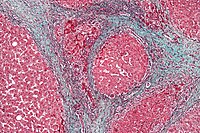
Photo from wikipedia
Background: Limited data exist on the pharmacokinetic profile of novel direct-acting antivirals in kidney transplant recipients. Daclatasvir is primarily eliminated through the biliary route and sofosbuvir through the renal route;… Click to show full abstract
Background: Limited data exist on the pharmacokinetic profile of novel direct-acting antivirals in kidney transplant recipients. Daclatasvir is primarily eliminated through the biliary route and sofosbuvir through the renal route; here, we report the pharmacokinetic profile of combined treatment with these compounds in a prospective study of hepatitis C virus (HCV)-positive kidney transplant recipients (EudraCT: 2014-004551-32). Methods: In this study, plasma samples of 16 HCV-positive kidney transplant recipients receiving daclatasvir and sofosbuvir were collected at 4 time points at days 1, 7, 14, 21, 56, and 84 after start of treatment. Inclusion criteria were stable graft function and an estimated glomerular filtration rate (eGFR) >30 mL/min/1.73 m2. Daclatasvir, sofosbuvir, and GS-331007 (inactive metabolite of sofosbuvir) plasma concentrations were determined using ultra-performance liquid chromatography quadrupole time-of-flight mass spectrometry. Results: All patients showed a rapid virological response with HCV RNA below the detection limit 21 days after the start of therapy (medium time to viral clearance). No difference of the areas under the concentration–time curve (AUC) of daclatasvir, sofosbuvir, and GS-331007 was observed between patients with an eGFR below or ≥60 mL/min. For GS-331007, no relevant changes of trough levels were observed over time. Mean GS-331007 trough levels were 339.5 ± 174.9 ng/mL in patients with an eGFR ≥60 mL/min and 404.3 ± 226 ng/mL in patients with an eGFR <60 mL/min at day 7 (P = 0.52). At day 84, GS-331007 trough levels were 357.8 ± 200.8 and 404.2 ± 70.2 ng/mL in patients with an eGFR ≥60 mL/min and in patients with an eGFR <60 mL/min, respectively (P = 0.51). The accumulation ratios of renally eliminated GS-331007 for AUC and Cmax did not significantly differ between the 2 eGFR groups at day 7. Conclusions: An impaired eGFR (30–60 mL/min) does not lead to a dose accumulation of daclatasvir, sofosbuvir, and GS-331007. This study provides the rationale for future studies investigating the pharmacokinetic profile of sofosbuvir-based HCV treatment in kidney transplant recipients with an eGFR <30 mL/min.
Journal Title: Therapeutic Drug Monitoring
Year Published: 2019
Link to full text (if available)
Share on Social Media: Sign Up to like & get
recommendations!